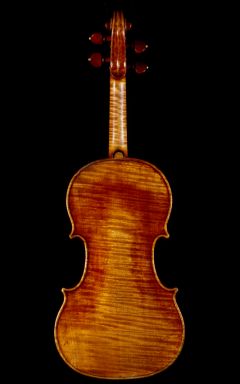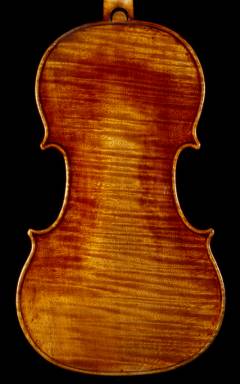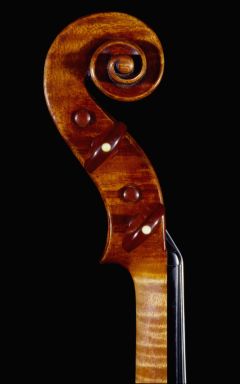The Lady Harmsworth Stradivari of 1703
Mouse over a thumbnail to see a larger view of that photo
Click on a thumbnail to see a full page image
This beautiful example from Stradivari's Golden Period is imbued with a cheerful, forthcoming tone as rich as its varnish color suggests. Charles Ervin sold the violin in 1990 under an installment contract which appointed him trustee for two years. During that time, in addition to careful measurements of the body and a growing appreciation of the subtleties of its tone while playing it, he conducted extensive microscope studies of its varnish.
The varnish revealed an undreamt-of cosmos of color, shapes, and flaming brilliance. We want to share this discovery with you in a separate section entitled "The Universe Within." (Click on the link to see the slideshow.) When Charles first saw the violin, its owner opened its case at a distance so that he could only see the belly from the side while seated parallel to it. He exclaimed, "It's a Strad!" She asked how he could know that without even examining it. "Because it glows," was his answer. The glow of the classical Cremonese varnish remains a hallmark of their instruments, setting them apart even from other Italian makers of that period as well as the makers of later periods. There is an inexhaustible beauty about these great instruments that extends from their design and woodwork to their sublime tone to the most minute features of their varnish. Everywhere one looks, there is joy.
The Question of Symmetry in Cremonese Violins
Simone Sacconi was the most celebrated violin restorer of the twentieth century, supervising Rembert Wurlitzer's workshop in New York and writing the monumental book, I segreti di Stradivari (The secrets of Stradivari), that radically changed the landscape in violin research. Sacconi saw more than 400 Stradivari instruments and greatly admired his work. According to Dario D'Attili who worked beside him at Wurlitzer's, Sacconi admired the French violinmakers even more than he did Stradivari and lamented that Stradivari would have been perfect had he only been French! When Charles asked Dario in what way the French were better in Sacconi's judgment, Dario answered that the French were symmetrically exacting in their productions, Stradivari was not.
It was not very long ago that asymmetries in human faces were recognized for the first time, one eye often set higher than the other, etc. When we have an assumption of symmetry, whether in faces or violins, that assumption constrains our vision, mashing that eye back down or pushing that scroll back upright. And so it is with the beautiful Lady Harmsworth, to Sacconi's lasting regret but to our lasting pleasure. The eye sees one reality, the mind imposes another. That unrecognized tension keeps our interest alive indefinitely without our realizing why. One glance at a French violin tells us everything there is to know; a thousand glances at an Italian violin rarely begin to show us its secrets.
If we look at the side view of the Harmsworth scroll, it is a perfect creation, full of grace. Yet its humanity can be seen peeping through in the front view of the scroll where the inner and middle turns of the scroll show distinct differences between treble and bass sides. On the bass side (the left side as we face the scroll), both the inner and middle turn bevels do not make straight lines from bottom to top, but are significantly concave. The bevels of the inner and middle turns on the treble side, however, are both quite straight. Each side is beautiful, and Stradivari may have intended to leave them deliberately asymmetrical to please the eye and tease the mind.
Another frequent element of asymmetry in Stradivari's instruments is the difference in the heights of the f holes, the bass f being lower than the treble by about one millimeter. The corners are often slightly displaced, but the consistency with which the bass f drops below the treble is more than an error, more than a mannerism, it signals an intention on his part that we are asked to interpret correctly if we can.
The Lady Harmsworth was made on the forma PG of 1689, just as was the Provigny of 1716 which Charles has used since 1979 as his favored model. The close similarity between the two violins has been an advantage in continuing to use the Provigny as a model, many small details having come to light in those two years that now inform his current work. And the bass f of the Provigny also drops below the treble by one millimeter. You may just be able to see it in these photos. Can you explain it?
Charles Ervin Violins, Inc.
6508 Shoal CreekAustin TX 78757
(512) 467-2277
(575) 613-5677
Website: http://www.ervinviolins.com/
E-mail: crervin@ervinviolins.com



